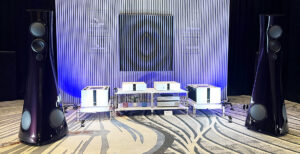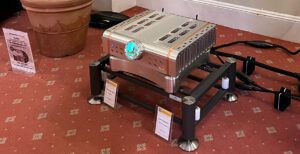First Listen: LH Labs Geek Out 1000 USB dongle-type headphone amp/DAC
- BLOG
- Chris Martens
- Dec 26, 2014

A number of months back, some of you may recall a surge of Internet buzz surrounding the LH Labs Geek Out—a small, but powerful and very high-quality USB-powered, dongle-type headphone amp/DAC. Part of what drew attention was not just the performance and technology on offer in the Geek Out, but rather the fact that it was one of the first products of its kind ever to have its development guided and funded entirely by a crowdsourcing process. For those not familiar with crowdsourcing, a bit of background is definitely in order.
Crowdsourcing enables companies such as LH Labs to offer previews of prospective products and to solicit investments/pre-orders from customers whose investments will be used to subsidize development costs for the products on offer. But a secondary, though no less important, factor is that those same investor/buyers are not only asked for pre-orders to help fund product development, but also asked for their specific input on the design of the proposed product. The implications of crowdsourcing are huge.
First, crowdsourcing means that firms like LH Labs can afford to hire development team members and then to create and launch new products without seeking investment from venture capitalists. Second, it means that LH Labs’ investors are customers who have a strong vested interest in seeing their new products turn out well. Third, it means that—in theory at least—the finalised product will be highly responsive to customer’s explicitly stated desires for specific product features, functions, and benefits. So, LH Labs gets to build a product portfolio (and production economies of scale) using third-party investment funds, while investor/buyers get cool products shaped in response to their stated desires. It all sounds pretty much like a win/win scenario doesn’t it? And, in many respects it is.
However, in practical, real-world terms, crowdsourcing can have its downsides. For example, with large numbers of investor/buyers giving input, there can be a corporate version of the ‘too many cooks spoil the broth’ problem. Another way of stating this is that crowdsourcing can lead to the problem of ‘specifications creep’, where so many new features (some not necessarily compatible with others) get added to the product’s design brief that it becomes difficult to know when to declare the product ‘finished’. What is more, despite the best of intentions, customer input—if not weighed and sorted very carefully—can lead the specifications for a given product to change dramatically and in unpredictable ways over time. When this happens, some buyers will of course be pleased, but others might wind up disappointed that their favourite product features have been deleted or modified beyond recognition via group inputs.
There is an almost imperceptible, but vital, distinction between ‘crowdsourcing’ and ‘crowdfunding’ that is relevant here. The former implies that both ideas and funds are ‘sourced’ from the ‘crowd’, while the latter merely asks the community for money, and the product is taken ‘as read’. If the Geek Out is the perfect example of a crowdsourced product, where both design criteria and revenue were subject to the demands of the masses, then Pono is a fine exercise in crowdfunding; no fine-tuning of the product by the investors; just buy your way onto the line forming for the product.
In practice the LH Labs Geek Out enjoys both the benefits, but also, to some degree, the downsides of crowdsourcing. On one hand, the Geek Out is obviously the result of a well-funded development effort and as a result it is a well-made, highly sophisticated product that offers a disproportionately large measure of performance for its modest price. Moreover, perhaps as the direct resulting of input from crowdsourcing investors, the Geek Out offers up-to-the-minute technologies and exudes a certain unmistakable ‘coolness’ factor that is very appealing.
On the downside, however, the Geek Out does show signs of having undergone some specifications creep along the way. Thus, some features that were highly touted back in the initial Geek Out product offering have literally disappeared, while other features not mentioned in the initial design prospectus have arrived to take their place. If you like the changes LH Labs has made, then you will be happy the Geek Out design is flexible and adaptable; on the other hand, if you valued the features that are now gone, you may lament the fact that ‘creeping excellence’ has redefined a product you loved in ways you could not have foreseen. Welcome to the complexities of crowdsourcing!
For those of you unfamiliar with LH Labs, the firm is a subsidiary of the high-end digital audio company Light Harmonic, which is best known for its spectacular looking, spectacular sounding, and spectacularly expensive Da Vinci DAC (arguably the first DAC to handle 384kHz/32-bit PCM files via USB and also one of the first DACs to handle DSD64 and DSD128 files). The man behind both firms is Larry Ho, who must be considered a digital audio maven extraordinaire, and you can see the influence of Ho’s design philosophy and all-around know-how in products from both firms. Think of Light Harmonic as the technical pathfinder, the firm that pushes the edges of the performance envelope to see what’s possible. In turn, LH Labs is the division responsible for bringing essential elements of the famous Light Harmonic sound down to price points where normal mortals with normal budgets can also afford to partake in the fun.
From the beginning, the LH Labs Geek Out was conceived as a metal-cased, USB-powered, dongle-type headphone amplifier/DAC—one that would incorporate pure class A analogue audio circuitry and would leverage Larry Ho’s DaVinci-derived design know-how to provide a DAC section that, in LH Labs’ words, can decode, “any audio file from MP3 to 384kHz/DSD 128.”
However, in its original conception, the Geek Out was also to have featured a user-selectable 3D soundstage enhancement circuit (known in LH Labs parlance as the ‘3D Awesome-ifier’) and was to have had a pair of side-mounted, up/down pushbutton-type volume controls. Early Geek Out units did, in fact, have these features, but through successive design iterations, both of these potentially desirable design features have disappeared in current production Geek Out units. See what I mean about ‘specifications creep’?
Here’s what happened to the now missing-in-action 3D circuit and pushbutton volume controls. Via a recent firmware update, modern day Geek Out units have dropped their former 3D circuitry altogether, adding instead a pair of highly desirable, user-selectable digital filter modes. The first mode, called ‘Time Coherence Mode’ (TCM) is described as, “LH Labs’ minimum phase digital filter and time optimization algorithm, which removes all POST ring from the original signal and realigns the impulse response. This presents the listener with a more well-defined and natural sound- stage.”
The second mode, called ‘Frequency Response Mode’ (FRM), “Uses a slow roll-off linear digital filter with our proprietary frequency domain optimization algorithm. This mode gives you a smoother and clearer sound with even lower THD+N than our previous version (1.0).“
As part of the same firmware update, LH Labs repurposed the Geek Out’s former up/down volume control buttons, turning them into digital file mode selector buttons; the convex-shaped button enables the TCM filter while the concave-shaped button enables the FRM filter—an elegant and simple solution.
Over time, the single Geek Out morphed into four models, each offering differing power output capacities. Today, however, LH Labs has distilled the Geek Out range down to the three models described below:
- Geek Out IEM 100 ($289) – A 100mW model that “has been tweaked and tuned especially for sensitive IEM’s.”
- Geek Out 450 ($199) – This 450mW model is similar in concept to the very first Geek Out units ever produced, and is said to be “perfect for headphones with an impedance less than 100 ohms.”
- Geek Out 1000 ($299) – A 1000mW model that is hands down the most powerful of all Geek Out units and is said to provide, “enough (power) to drive any headphone, including those big, esoteric cans.”
Partly because I love listening through the aforementioned “big, esoteric cans,” but also because my gut instinct was that the most powerful unit would potentially be the most versatile, I requested a sample of the Geek Out 1000 to try out (my sample came in a lovely red-anodized finish, but there are options for silver and black-anodized treatments available as well).
There are four or five other points prospective owners might want to bear in mind in considering the Geek Out:
- Heat: The Geek Out uses pure Class A amplifier circuitry, so that the tiny amp/DAC can and does get fairly hot (~70 degrees Celsius) in day-to-day operation. But if you resolve yourself to put up with the heat, you’ll be treated to sound that’s smooth, effortlessly precise, delicate, and beautifully controlled (and in the high-output models, very powerful, too).
- Volume is controlled via application software: The Geek Out’s volume output levels are controlled directly from the user’s computer, or more specifically from your music application software (e.g., iTunes, JRiver Media Center, etc.) in keeping with the USB audio 2.0 standard. LH Labs says that, “when you turn down the volume on your computer, Geek Out takes over with its internal 64-bit digital attenuator, keeping your music bit-perfect and giving you the highest precision control with the lowest distortion possible.”
- (Optional) Volume can also be controlled via the LH Labs device driver: It helps to remember that there is one other (also software-driven) means of controlling volume output levels for the Geek Out and that is through the pop-open control panel of the LH Labs Geek Out device driver. I found that in many instances the Geek Out driver control panel offered more finely graduated and thus more useful volume control setting than my music application software did.
- Device driver requirements: The Geek Out requires no additional device drivers for use in USB 2.0-compliant Mac or Linux systems but it does require an LH Labs-provided driver for use in Windows-based systems (like my reference system). The Windows driver is available for download from the LH Labs website.
- Mind Geek Out’s two output jacks (they aren’t the same): Finally, Geek Out units provide two output jacks that make it possible for two listeners to share the output of the amp. The output jacks, however, are not identical because they have differing output impedences (labeled 0.47 ohms and 47 ohms, respectively). According to LH Labs, the lower impedance jack is the go-to choice for most headphones, while the higher impedance jack is said to work better for less efficient ‘phones. The higher impedance jack is also the output of choice when using the Geek Out as a DAC to feed your home hi-fi system. My practical suggestion is that you try both jacks and then let your ears be your guides in deciding which jack works best with any given set of headphones or earphones.
Normally in such ‘first listen’ circumstances, we’d naturally spend more time discussing our first impressions on the sound quality by now. However, I suspect the ‘how’ and the ‘why’ of the Geek Out is one of the more interesting tales in audio at this time, and deserves some more oxygen than usual, because I am convinced this kind of product development and funding cycle is going to be a regular feature of an increasing number of audio products in the future. As such, potentially more than just the future of the Geek Out rests on its own success.
However, sonically speaking, my first observation is that the Geek Out sounds far more accomplished than it has any right to do given its size and price. Part of the fun of the Geek Out is simply reveling in the fact that this little, tiny, dongle-sized amp/DAC sounds very, very much like a bigger and far more costly desktop unit. So impressive is the Geek Out’s sound that I might summarise it with the acronym ‘GGR’, which stands for Grunt, Grip, and Refinement.
The Geek Out 1000 has enough ‘Grunt’–that is, sheer dynamic oomph and authority–to drive such relatively inefficient headphones as the new HiFiMAN HE-560 to reasonable levels, yet it also has enough delicacy and finesse (not to mention sufficiently quiet circuitry) that you can, in a pinch, get quite good results using the Geek Out 1000 even with highly sensitive IEMs (just mind the volume control setting so that you don’t fry your ears or earphones with excessive output).
But, I think the Geek Out’s defining characteristic is an overarching quality of ‘Grip’ that I personally find quite pleasing and comforting in day-to-day use. Because today’s best in-ear, on-ear, and over-the-ear transducers are incredibly responsive and precise sounding, the last thing you want is an amp/DAC that doesn’t really have the transducers under control. But, without becoming in any way a sonic ‘tyrant’, the Geek Out can and does maintain proper control, always letting the music call the tune, which is how things ought to be.
Finally, the Geek Out offers a quality of ‘Refinement’–in particular, a certain richness, delicacy, and complexity of harmonic structure–that I’ve rarely if ever encountered in a small dongle-type USB amp/DAC before. Once again, this quality reinforces the idea of the diminutive Geek Out offering big component performance from a truly pocket-sized package.
We haven’t made a formal commitment to review the Geek Out in Hi-Fi+, but if we do take that step we’ll provide even more detailed commentary on its sound. In the mean time, please know that LH Labs’ Geek Out is well worthy of a careful listen. And, given past history, there is every reason to suppose that the digital audio mavens over at LH Labs will continue to tweak, tune, and refine its performance over time, making updates available to the LH Labs faithful via a series of periodic firmware and device driver updates. Some things really do get better over time, and it appears the Geek Out is likely one of them.
Happy listening.
Tags: FEATURED
By Chris Martens
More articles from this authorRead Next From Blog
See all
AXPONA 2024 Show Report Part One
- Apr 19, 2024

Audio Show Deluxe 2024: A photo show report
- Mar 28, 2024

Paul Messenger 1949-2024: A personal tribute
- Mar 26, 2024

Bristol Hi-Fi Show 2024: See You There!
- Feb 21, 2024















